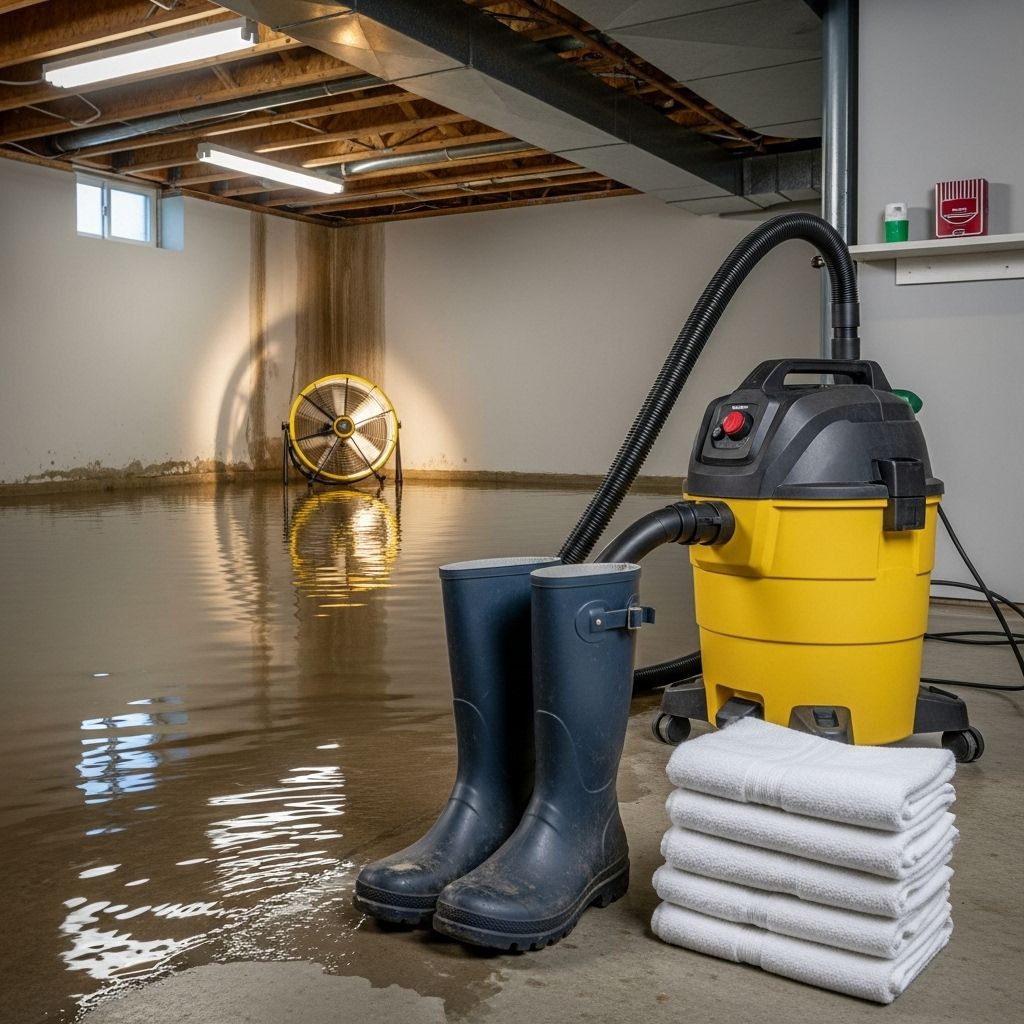How to Handle a Flooded Basement: Step-by-Step Cleanup & Prevention
A clear roadmap to restore safety and keep your lower level dry and mold-free.

A flooded basement can be one of the most stressful home disasters, but acting quickly and strategically can minimize damage to your property and lower the risk of health hazards. Whether the cause is heavy rainfall, broken pipes, or other issues, understanding the best approach is crucial to restoring your basement’s safety and livability. This guide provides a thorough step-by-step roadmap for assessing the damage, cleaning up efficiently, ensuring complete drying, preventing mold, and safeguarding your home for the future.
What’s the First Thing I Should Do if My Basement Floods?
- Ensure Safety First: Always shut off electricity to the flooded area before entering. If you’re unsure how to do this, call a professional electrician. Water and electricity are a dangerous combination.
- Determine the Water Source:
- If the flooding was caused by heavy rain or storms, do not begin repairs until the weather has cleared and it’s safe to enter the basement.
- If the source is a burst pipe or internal plumbing issue, take action as soon as you notice flooding to reduce potential damage.
- If you can’t identify the source of the water, or if the situation seems hazardous, contact a professional. Plumbers, basement waterproofing experts, or disaster restoration companies can provide emergency response and assessment.
As you work through the challenges of a flooded basement, it’s essential to consider how to finish your basement effectively. Understanding the proper steps to create a dry, cozy space can make all the difference. For a complete overview, check out our guide on essential steps to finish your basement properly. This resource will equip you with insights and tips that ensure safety and comfort in your newly restored area. - Document the Damage: If you have flood insurance, take photographs or videos of the flooded area and damaged items for your claim before you begin cleaning up.
How Do I Clean Up After a Flood?
- Remove Water Quickly:
- Start by extracting water with a sump pump, wet/dry vacuum, or simply using mops and buckets for smaller amounts.
- Never use a regular household vacuum—it’s not designed for water and can be hazardous.
- If standing water is deeper than a few inches, or if the water is contaminated (e.g., with sewage), hire a professional water damage restoration service.
- Move Out and Dry Damaged Items:
- Relocate water-damaged belongings to a well-ventilated area. Allow at least 48 hours for items to dry—toss anything that’s still soaked after that to prevent mold growth.
- Discard wet cardboard boxes. They are especially vulnerable to bacterial and mold growth, so replace them with plastic storage bins.
- If your basement is carpeted, remove and discard the carpet and padding immediately. This material holds moisture and increases mold risk.
- Increase Air Circulation and Drying:
- Open doors and windows to increase ventilation as soon as weather permits.
- Set up fans and dehumidifiers throughout the basement to speed drying and reduce humidity.
- Continue drying for several days; monitor for persistent dampness and hidden moisture in walls and floors.
- Clean and Disinfect All Surfaces:
- Scrub floors and walls with hot, soapy water to eliminate dirt and bacteria left by floodwaters.
- Sanitize with a bleach solution: One cup of bleach per gallon of water is a standard guideline for disinfecting hard surfaces.
- For porous or soft materials (e.g., upholstered furniture, insulation), professional cleaning or replacement is often necessary.
- Replace Damaged Building Materials:
- Remove and discard any drywall, insulation, or paneling that got wet. These materials are difficult to dry and prime locations for mold growth.
- Contact a contractor or water damage specialist for repairs, especially if extensive material replacement or structural work is required.
How to Prevent Mold After a Basement Flood
- Act quickly: Mold can develop within 24-48 hours of water damage. The faster you dry out and clean your basement, the lower your risk.
- Use dehumidifiers: Keep dehumidifiers running for several days, particularly in humid weather. Aim for a target humidity below 50%.
- Inspect hidden areas: Check behind wall panels, under flooring, and inside insulation for moisture or visible mold.
- Discard items that can’t be thoroughly dried: This especially includes cardboard, paper, insulation, and fabric-based items.
- If you spot visible mold or a persistent musty smell, hire a mold remediation expert.
Common Sources of Basement Flooding
- Heavy Rain or Flash Floods: Water can enter through foundation cracks or poor drainage.
- Burst Pipes and Plumbing Failures: Sudden pipe ruptures, leaking water heaters, or failed connections.
- Sump Pump or Sewage Backup: Sump pump failure and clogged drains can cause rapid flooding and may introduce sewage.
- Groundwater Seepage: Water naturally finding its way through basement walls or floors, especially if gutters and downspouts aren’t directing water away from the house.
What Not to Do After a Basement Flood
- Do NOT enter a flooded basement before shutting off power. Electrocution risks are high when water meets live wiring or outlets.
- Don’t use a standard household vacuum to remove water. Only use a wet/dry vacuum designed for liquid pickup.
- Don’t delay cleanup. The longer water sits, the higher the risk of mold, bacterial growth, and structural damage.
- Do not keep water-damaged items indoors for more than 48 hours. Lingering dampness will fuel mold and mildew.
- Don’t attempt repairs in structural areas with significant cracks or warping—bring in experts for assessment and safety clearance.
When to Call in a Professional
- The flooding depth is more than a few inches or involves sewage, hazardous waste, or significant contamination.
- Home electrical systems are affected and you cannot safely shut off power to the basement.
- You notice signs of severe structural damage—large cracks, misaligned walls, or shifting floors.
- Mold infestation is visible or producing a persistent odor even after your cleaning attempts.
- You are unable to dry the basement fully with fans and dehumidifiers after several days.
- If you need help with insurance claims, water damage repair, or basement reconstruction.
Proactive Steps to Prevent Basement Flooding in the Future
- Install or maintain a sump pump with a battery backup: Sump pumps are critical for draining rising water, and battery backups keep them running during storms or power outages.
- Grade your landscaping properly: Make sure soil and concrete slope away from the house foundation to direct rainwater away from the basement walls.
- Regularly clean gutters and downspouts: Blocked gutters cause water to overflow near the foundation instead of being safely channeled away.
- Seal basement cracks: Use appropriate sealants on visible cracks in basement walls or floors.
- Consider installing a French drain system: Subsurface drainage pipes around the foundation can help divert groundwater away from the basement perimeter.
- Test water alarms and moisture sensors: These devices can alert you to rising water before you have major flooding.
FAQs: Flooded Basement Cleanup
Q: How quickly do I need to act after my basement floods?
A: Begin cleanup immediately. Mold can start growing as soon as 24–48 hours after water exposure. The faster you remove water, dry, and clean, the better.
Q: Can I save furniture and other belongings after basement flooding?
A: Items made of solid wood, metal, or hard plastics can sometimes be salvaged if they are dried and cleaned promptly. Upholstered items, particle board, and cardboard are usually best discarded if they become soaked.
Q: What are signs of mold after a basement flood?
A: Look for musty odors, black, green, or white fuzzy patches, or stains on walls, floors, or stored items. Mold can appear within days and may grow in hidden areas like under floors or behind drywall.
Q: Do I need to replace drywall or insulation after flooding?
A: Yes. If drywall or insulation has become wet, it is nearly impossible to dry thoroughly and can harbor mold. Removal and replacement are recommended to ensure safety.
Q: How can I ensure the basement is fully dry?
A: Use multiple large fans, portable heaters, and professional-grade dehumidifiers. Measure humidity levels (target: below 50%). Check for hidden pockets of moisture with a moisture meter or via professional assessment.
Essential Flood Recovery Checklist
| Step | Action | Details / Tools Needed |
|---|---|---|
| Ensure Safety | Shut off electrical supply to the basement | Breaker switch, professional help if unsure |
| Stop Water Source | Locate and close source of flooding | Main water shut-off, plumber |
| Document Damage | Take photos/videos | Smartphone/camera, notebook |
| Remove Standing Water | Extract all water from basement | Wet/dry vac, sump pump, mops, buckets |
| Dry and Move Items | Relocate and air out belongings | Dry, well-ventilated space, discard ruined items |
| Clean & Disinfect | Wash floors, walls, fixtures | Soap, bleach, brushes |
| Discard Water-Damaged Materials | Remove soaked drywall, insulation, carpet | Pry bar, contractor bags, professional service |
| Prevent Mold | Dry thoroughly with fans, dehumidifiers | Large fans, dehumidifier, thermometer/hygrometer |
| Professional Help | Contact if major damage, electrical, or sewage issues | Restoration specialist, electrician, plumber |
Expert Tips for Post-Flood Basement Recovery
- Wear protective gear (gloves, boots, masks) during cleanup to avoid contact with contaminated water or debris.
- Monitor your health: If you develop respiratory issues, eye irritation, or allergies after a basement flood, consult a physician and check for mold contamination.
- Invest in waterproof storage solutions (plastic bins, shelving) to protect belongings from future moisture damage.
- Schedule regular basement inspections (at least once a year) for cracks, leaks, and moisture intrusion—especially after heavy storms.
- Consider a basement-specific insurance policy if you live in a flood-prone area.
References
- https://www.servicemasterrestore.com/servicemaster-at-bakersfield/why-us/blog/2025/march/how-to-clean-concrete-basement-floors-after-a-flood-a-step-by-step-guide/
- https://www.countryliving.com/home-maintenance/cleaning/a30569555/flooded-basement/
- https://www.basementsystems.com/company/news-and-events/34005-how-to-clean-a-flooded-basement.html
- https://www.panhandlecr.com/water-damage-restoration/water-damage-articles/handle-basement-water-damage
- https://www.youtube.com/watch?v=xEKSzbv_QRY
- https://www.floodsafety.com/national/property/cleanup
- https://www.youtube.com/watch?v=3YO5PVIY1Bk
Read full bio of medha deb












